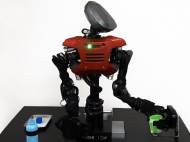SOINN enables robots to learn and adapt to new situations
 Researchers from the Hasegawa Group at the Tokyo Institute of Technology are developing a robot capable to think, learn and take on tasks it hasn’t tried before. By using Self-Organizing Incremental Neural Network (SOINN), the robot can think in a way similar to humans, because it can make educated guesses and decisions based on its past experiences and knowledge.
Researchers from the Hasegawa Group at the Tokyo Institute of Technology are developing a robot capable to think, learn and take on tasks it hasn’t tried before. By using Self-Organizing Incremental Neural Network (SOINN), the robot can think in a way similar to humans, because it can make educated guesses and decisions based on its past experiences and knowledge.
“So far, robots, including industrial robots, have been able to do specific tasks quickly and accurately. But if their environment changes slightly, robots like that can’t respond. This robot remembers only basic knowledge, and it can apply that knowledge to its immediate situation”, said Osamu Hasegawa, Associate Professor at the Tokyo Institute of Technology Imaging Science and Engineering Laboratory. “If it doesn’t know enough, it stops, and reacts by saying ‘I can’t do this because I don’t know how’. So, if you teach this robot the things it can’t do, it incorporates those things as new knowledge, and it can solve other problems, by including that knowledge.”
Applying artificial intelligence in the real world environments is inevitably more complex, due to changes in the environment. Since new situations emerge, it’s necessary to jeep learning at the spot and adapt to new information. In order to rise to the challenge, the researchers created SOINN which is very light on computation, and it can learn while eliminating noise from the new information that comes in. It is based on Growing Neural Gas (GNG) and Self-Organizing Map (SOM) algorithms.
In a simplified experiment, the robot was tasked to pour a glass of water, make it cold, and then give it to a person. In order to simplify the control and sensors needed to perform the task, small orange granules were used instead water, and a blue cube was used as an ice cube. Before it performed the task, the robot observed its surroundings and adapted to the new situation. Since the robot had both of its hands full, its SOINN realized that it will need to either put down the bottle or the cup to put the “ice” in the “water”.
Similarly to European RoboEarth project, where a robot can rely on experiences of other robots connected to a network, the SOINN is able to obtain information from other sources, including the Internet and other robots’ experiences and knowledge, in order to perform tasks already perfected by other robots.
“For example, suppose this robot doesn’t know how to make tea, and it’s sent to an elderly person who lives alone. And suppose that person asks it to make a cup of green tea. The robot doesn’t know how, so it asks robots around the world how to make tea. Suppose, for example, that a robot in the UK tells it how to make British-style tea. We think this robot will become able to transfer that knowledge to its immediate situation, and make green tea using a Japanese teapot”, said Hasegawa.
For more information about the research you should visit the Hasagawa Lab page.









Leave your response!